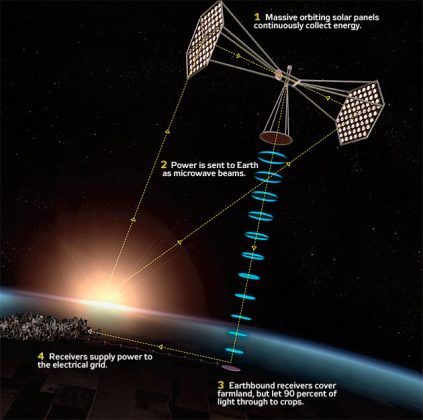Space-based solar power operational in California by 2016?
 The idea of space-based harvesting of solar power has been around since the 1970s, and now California utility Pacific Gas & Electric (PG&E) wants to bring the concept to its realization. A few days ago state regulators approved PG&E’s request to buy electricity from an orbiting solar power plant – if the company designing the project can ever get it off the ground. Solaren Corp., a startup in Los Angeles County, plans to place a large array of solar panels in orbit, where they would bathe in near-constant sunshine undimmed by the Earth’s atmosphere.
The idea of space-based harvesting of solar power has been around since the 1970s, and now California utility Pacific Gas & Electric (PG&E) wants to bring the concept to its realization. A few days ago state regulators approved PG&E’s request to buy electricity from an orbiting solar power plant – if the company designing the project can ever get it off the ground. Solaren Corp., a startup in Los Angeles County, plans to place a large array of solar panels in orbit, where they would bathe in near-constant sunshine undimmed by the Earth’s atmosphere.
The plant would use electromagnetic waves to transmit power to a receiving station in Fresno County. They plan to build the world’s first space-based solar power generator, that will in turn be the first 24-hour solar generator (except during the spring and fall equinoxes).
“I’ll be the first to admit that our reach may exceed our grasp in this instance,” said Michael Peevey, president of the California Public Utilities Commission, which unanimously approved PG&E’s agreement with Solaren on Thursday. “But in the words of poet Robert Browning, ‘A man’s reach should exceed his grasp, or what’s a heaven for?’ ”
As part of the contract, PG&E will purchase 1,700 gigawatt hours each year for 15 years. That’s enough to generate power for thousands of homes. Solaren’s power won’t be cheap–PG&E estimates that it will cost more than 12.9 cents per kilowatt-hour (the standard rate), so the utility is obviously betting that costs will eventually come down. Space-based solar power also has the advantage of being available 24/7, unlike ground-based solar panels that only work during the day.
Solaren engineers will design solar arrays and satellites, perform test launches, and finally move to the pilot stage. It’s an ambitious plan, and one that comes with a lot of risk for the company, as PG&E has only agreed to pay for power delivered. Space-based solar power won’t be cheap, either. PG&E says that the cost of its contract is “above-market” (more than 12.9 cents per kilowatt-hour).
If companies like Solaren want to make it, they’ll have to prove that their technology can be deployed cheaply, efficiently, and safely. All of these hurdles have yet to be surpassed, but at least we’ve moved beyond the concept stage after nearly 40 years of talking about space-based solar.
If all goes well, Solaren’s satellites will go live in 2016. Pilot tests have yet to be conducted, however, so the viability of the company’s plan is still up in the air. Solaren isn’t the only organization looking to take advantage of space solar. The Japanese government also plans to have a pilot space-based solar project ready by 2015.










ideas! that is fantastic,can just change the generation of the trasfer of lelctiocity and developemant of electicity.